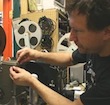|
Author
|
Topic: what is a good 16mm sound projector?
|
|
|
|
|
Richard C Patchett
Master Film Handler

Posts: 424
From: Flint Mi 48506
Registered: Dec 2007
|
 posted June 12, 2009 10:29 AM
posted June 12, 2009 10:29 AM




Greetings Rob
Whens the stampede in Calgary
Hope this helps
Manual:
You physically take the film in your hands and thread (lace for you folks in the UK)
the film through the entire film path. You open every sprocket guard, open the film
gate, set the tension of the film around the sound drum, and loop film around the
rollers as the film exits the projector. All projectors from the very beginning of the
development of projectors up until around 1962 were manually threaded. This is
good because the projector and film path were less cluttered plus you had to know
something about film so you wouldn't destroy either the film or projector. Film can
be stopped at any point in the reel and unthreaded easily if you don't wish to see the
entire movie.
Auto load:
You flip a lever and feed film into an entryway. The film threads itself through the
entire film path. When the film exits the projector you give the film a slight "tug" to
trigger the release linkage and take the machine out of the automatic thread mode.
The numerous linkages and guidance hardware are complicated. That's why auto
load machines are the most expensive to purchase brand new. Film can be stopped
at any point in the reel and manually unthreaded with a little difficulty. By the way,
AUTOLOAD is a registered trademark for Bell & Howell's line of automatic threading
projectors. Bell and Howell invented automatic threading projectors in late 1962 with
the introduction of the famous model 552 and its baby brother the model 545. Film
leader (the first 3 feet for sure) must be in good condition and free of sticky tape,
folds, kinks, torn holes, etc.
Slot load:
You flip a master "loading lever" and the entire film path opens up. Then you just
sort of 'lay' the film in the slot. Then flip the master lever into the run position and
show your movie. Film can be stopped at any point and unthreaded easily. Some
machines allow you to actually rewind the film while still in the film path. There is
usually some safety interlock switches preventing rewinding if any of the sprockets
and claw is still engaged with the film or damage would result! These machines are
also complicated internally, difficult to clean, and can be problematic. Slot load and
channel load are the same terms. By the way, Graflex invented the slot load system
in 1966.
--------------------
RCís Classic Collection
16 mm Parts & Service
Elmo, Eiki, Bell & Howell +
http://www.rcsclassic16mm.com/
| IP: Logged
|
|
|
|
Dino Everette
Phenomenal Film Handler

Posts: 1535
From: Long Beach, CA USA
Registered: Dec 2008
|
 posted June 12, 2009 06:12 PM
posted June 12, 2009 06:12 PM



I say Elmo 16-CL, they are inexpensive and common. They are easy to thread, understand, and clean, and the parts that can go bad are readily available (like the rubber rollers). They sound really good when run through a small sound system. They have accessory parts that fit nicely and can open you up to scope/larger picture, etc (I recently bought an elmoscope lens on ebay for $50), easy to clean and maintain, as well as find manuals, etc...I'm n elmo man all the way ![[Big Grin]](biggrin.gif)
--------------------
"You're too Far Out Miss Lawrence"
| IP: Logged
|
|
|
|
|
|
|



 UBBFriend: Email this page to someone!
UBBFriend: Email this page to someone!
 Printer-friendly view of this topic
Printer-friendly view of this topic



 UBBFriend: Email this page to someone!
UBBFriend: Email this page to someone!
 Printer-friendly view of this topic
Printer-friendly view of this topic